Descon Flying Purple People Eater
Scratch - Flying Purple People Eater {Scratch}
Contributed by Robert Galejs
| Manufacturer: | Scratch |
Robert Galejs, NAR 69317

I ordered the Descon X HP kit from Blackhawk R&D and here's what I got.
 There
appears to be an extra 3" coupler and bulkhead that were not on the
original Descon10 website, but I didn't reralize that until I was essentially
finished with my entry.
There
appears to be an extra 3" coupler and bulkhead that were not on the
original Descon10 website, but I didn't reralize that until I was essentially
finished with my entry.
So many tubes... What should I do?
I like the look of short/fat rockets, so I decided to try something in the Mars Lander aspect ratio: short and fat. Fin pods would look cool but how could I to make the pods with only two small nose cones...?
Cut them in half!
If I angled the pods in as well, that should increase the stability and make for an interesting look. I sketched out a few fin/pod designs and found one that looks neat. Giving the rocket a fat look was just a matter of piling on tube fins. Finding angles that looked good took a little more sketching. Tip angles of 30, 45 and 67.5 degrees looked pretty good.
I decided to make the fins through the wall and to the motor mount as well as through the pods in order to make them strong. This rocket would be pretty heavy, especially after adding nose weight for stability.
Construction
It was kind of scary cutting up all of the tubes, since I knew there would be little chance of changing my mind after the fact. Most of the tubes I cut with a power miter saw, except for the upper most tube fins where I had to use a table saw due to the sharp angle.
I cut the 54 mm nose cones in half by placing them in a 54 mm tube and running the nosecone through a table saw down to the shoulder. I finished the job with an exacto knife.
I used the 3 in coupler as the lower half of the body tube in order to get a good length on the lower ring fins that ended up being 4" long. Fin slots were cut into the coupler at this point. Because of the coupler being used as the lower body, the centering rings supplied would not fit without lots of work, so I drilled a hole in the bulkheads (these fit inside of the coupler) turning them into centering rings. You can see the motor mount assembly below. I used some steel wire looped through the upper centering ring as a shock cord attachment point. I'll use the actual centering rings as decoration.
The lower ring fins had to have some slots cut into them to accommodate the fins. Two of them had standard slots cut into them for the fins to poke straight through and the other four had side slots cut to accommodate the fins coming through at a tube fin-tube fin junction. These tubes also had small pieces of body tube glued on where they faced the coupler to make up for the smaller diameter of the coupler. Six tubes will cluster around a tube of the same diameter, but not a smaller one.

In order to securely hold in the half-nose cones, I cut up short section of the 54 mm couplers to fill out the other half of the shoulder that was missing, with slots added for the fins. The fin pod assembly is shown below. I used West Systems epoxy with collodial silica thickener for the high stress sections of this rocket and normal 15 minute hobby epoxy for the rest.
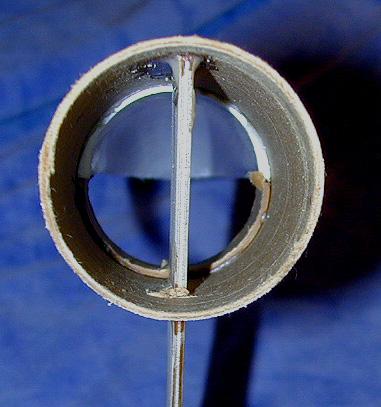
A side view of the fin assembly is shown below. The hole in the fin was added as a little detail.
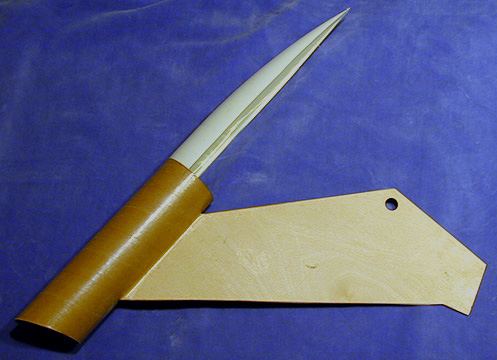
Next I glued the motor mount into the 3" coupler and the coupler into the body tube.
Now for the really hard part of the assembly. I had to glue on the 4 fin assemblies and six lower ring fins keeping everything all aligned while the epoxy set. I used the West systems epoxy to give me time to adjust everything, but then had to hold it all in place while the epoxy cured. It took me about a hour to get it all in place and masking taped together, but I found that the whole assembly slowly sagged to the ground. I fixed this by putting four small brads through the very outer edge of the fin pods into a big plywood sheet. Now the sagging would force the fins against the motor tube.
Phew...


And a top view...

The remaining tubes were relatively easy to add. Since they would see little stress during flight or landing I used 15 minute hobby epoxy.
The three centering rings were added to the 29 mm motor mount tube with 2 6-32 T-nuts in the bottom ring for motor retention.
Here's the semi-finshed product from the side...


and from the top

The fins seemed kind of flimsy at this point, so I added two 3/4" strips of plywood at the trailing edge of the fins for strength and stiffness.
Here's the final product after the initial painting. I had an opportunity to test fly it and did not have sufficient time to add more painting detail.

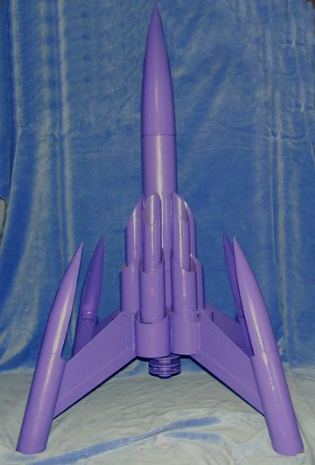
Now that doesn't quite look right to me. Let's spice it up a bit...
I painted the "nails" and the insides of the tubes a gloss red and added some gold auto pinstriping in a couple of spots.

That looks pretty much done to me.
Where's the CP?
To be conservative, I modeled the CP in VCP without the angled pods. With a loaded motor I wanted to have about 1/2 a caliber of stability (based on the outer 9" tube fin diameter).
The flat fins were straight forward to model. The tube fins were approximated by 3 sets of ring fins with a 6 fin assembly inside of each ring.
It took about 12 oz of nose weight to get this 1/2 caliber margin so I ended up with about a 5.5 pound liftoff weight.
In order guarantee the pods would really increase stability and not do something unexpected, I blocked off the hollow portion of the pod with a circle of cardboard. What I was worried about was the tube transitioning from a pure drag to a lifting state that could destabilize the rocket.
Sorry, no mathematical treatise this time around... but my estimates and approximations seem to have worked...
Flight Log
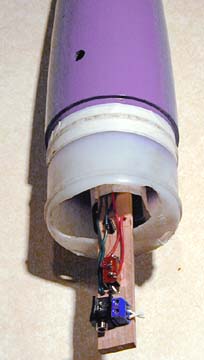 Since this was quite an unusual
design and discretion being the better part of safety, I placed a magnetic
apogee detector (MAD) in the nose to eject the parachute as soon as the rocket
tipped over in case something really bad happened off of the pad.
Since this was quite an unusual
design and discretion being the better part of safety, I placed a magnetic
apogee detector (MAD) in the nose to eject the parachute as soon as the rocket
tipped over in case something really bad happened off of the pad.

I also had little confidence of my estimate of drag coefficient ( I am guessing something on the order of 2-3) so the choice of motor delay was uncertain and the MAD would give a close to apogee deployment.
 I chose the H128-S for
the first flight and it flew quite nicely. It took off relatively quickly and
straight . It then had what seemed like a very slow arcing flight to apogee.
(the rod was angled away from the crowd, just in case)
I chose the H128-S for
the first flight and it flew quite nicely. It took off relatively quickly and
straight . It then had what seemed like a very slow arcing flight to apogee.
(the rod was angled away from the crowd, just in case)
A liftoff shot is shown below. WRASP estimated an altitude of about 400 feet and that's about what it looked like. The parachute ejected right at apogee and the rocket landed relatively softly on a 72" parachute. Next time I'll fly it on an H180.
The folks at the Frontier Rocketry April 20 launch in Halifax, MA seemed to get a kick out of this rocket. Jason Maranhao caught the flight on video.
When people saw my entry in Descon 10, some people (well, one for sure) complained that I had more tubes to work with than in the Estes DC-X kit and that I couldn't have made the model without those extra tubes. They were wrong... I bought a DC-X kit and, using only materials in the kit, built a 1/3 scale downsized Purple People Eater of Death (unpainted at the moment). It turns out that you can make all sorts of tubes out of the color insert. Keep that in mind the next time a kit bash contest comes around...

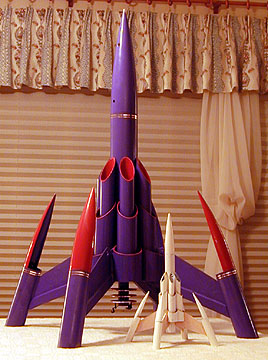
Sponsored Ads
 |
 |











